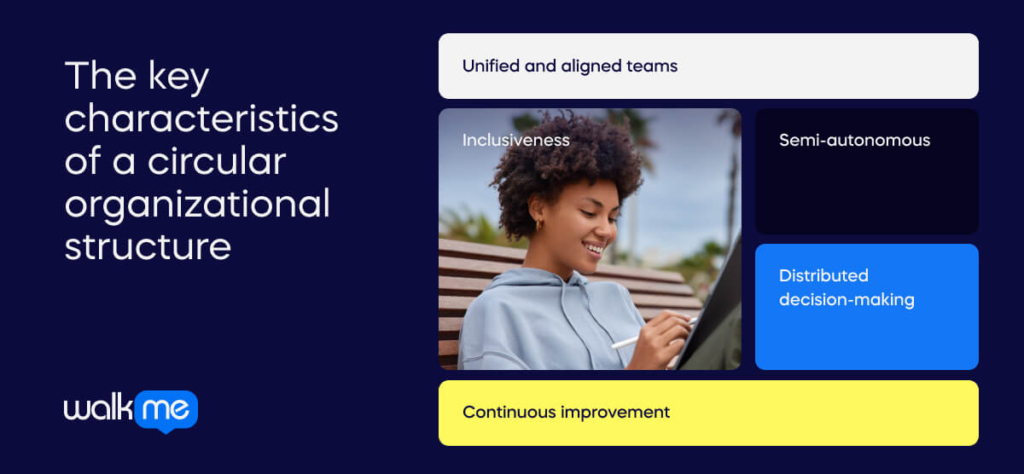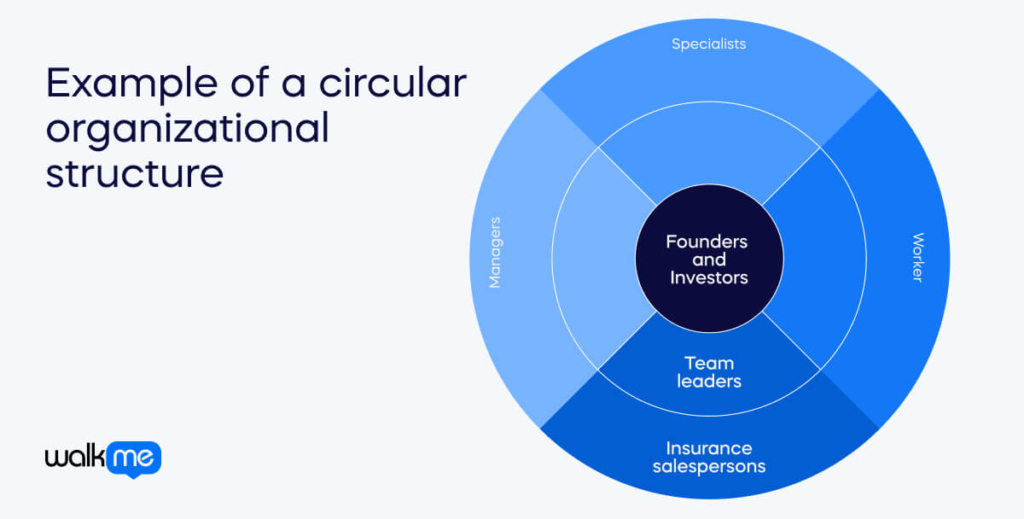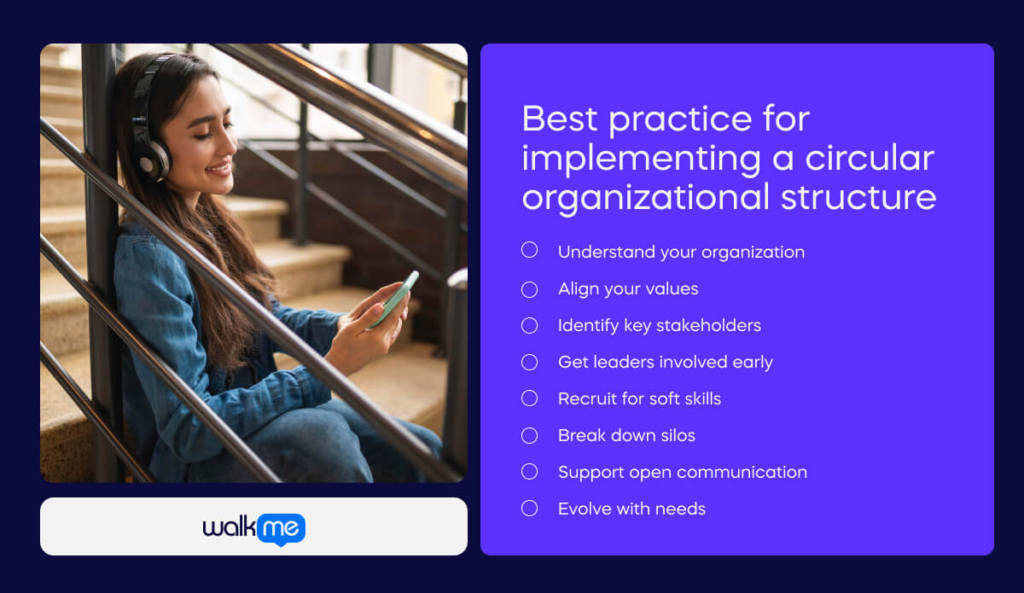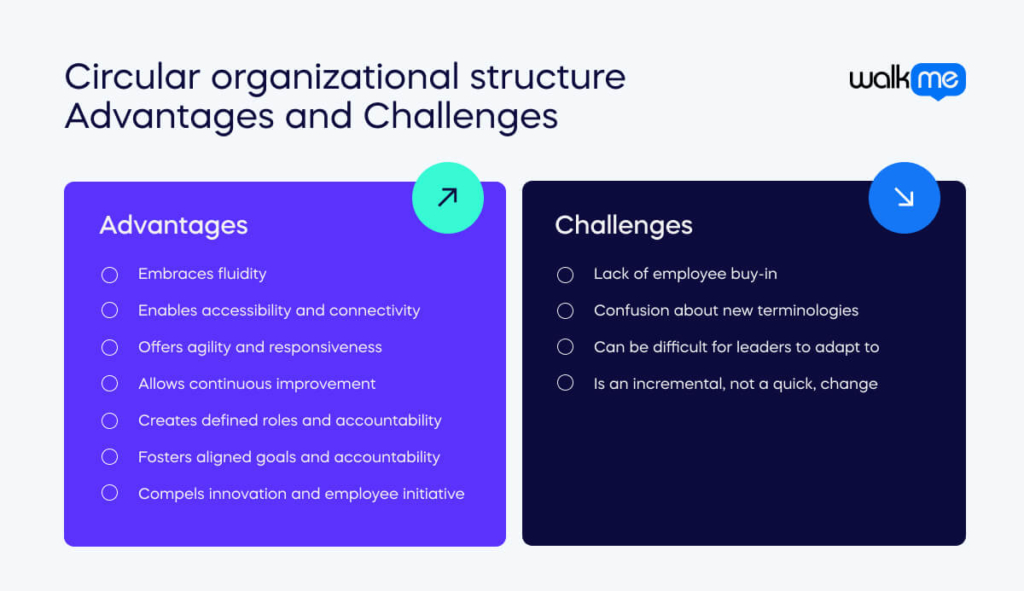An organizational structure holds a business together and gives it shape. It clarifies roles and responsibilities, reducing confusion and conflicts while assigning tasks to those best equipped, boosting productivity.
Different structures meet various needs, allowing companies to adapt to market shifts and internal changes. This adaptability often relies on effective change management, ensuring employees can transition smoothly when new processes or frameworks are introduced. Empowered employees benefit from this clarity, leading to higher job satisfaction and stronger retention.
A scalable structure also supports growth without major disruptions and optimizes resources to reduce waste. The circular organizational structure is one such model. Rather than replacing existing frameworks, it emphasizes alignment, collaboration, and shared outcomes.
This article defines a circular structure, outlines how it compares to a hierarchical model, and explores its benefits, challenges, and best practices.
What is a circular organizational structure?
A circular organizational structure uses a hierarchy. Higher-level employees occupy the inner rings, and lower-level employees are on the outer rings. Leaders sit at the center of the organization.
They send orders outward, not down the chain of command. Many structures have departments working on their own with individual goals. This structure removes that strict separation. It sees the bigger picture. All departments are part of the same whole.
What are the key characteristics of a circular organizational structure?

The main features of a circular organizational structure are:
Inclusiveness
Instead of a top-down pyramid, the circular organization moves from the center out. The center-most circle represents the highest-level officer. The outer circles represent entry-level employees and individual contributors.
But, the circular structure is more inclusive. It improves communication. It makes management more accessible. Instead of executives barking orders from the top, leaders direct influence outward.
Unified and aligned teams
In a circular structure, all people and teams are part of the same whole. They work together in alignment. This approach suits organizations wanting to move away from rigid hierarchies. It fosters innovation, agility, and adaptability.
Each circle has set roles and accountabilities. These enable it to fulfill its purpose, such as marketing, operations, or customer experience. Circles make final decisions on their own without top-down approval.
Semi-autonomous
Circles are semi-autonomous. Small circles nest within larger ones. Nested circles focus on specific tasks. Parent circles handle overarching responsibilities. This ensures the circles take all details into account.
Circular structures lack rigid job titles and descriptions. You can create roles with specific purposes, domains, and accountabilities. One person can own many roles. Roles can shift and grow with business goals. This is useful for start-ups and growing companies.
Distributed decision-making
Decision-making authority is spread across the organization. Employees at all levels make decisions related to their roles.
Employees have flexible roles. They take on responsibilities based on their skills and interests. This leads to a dynamic work environment. This structure emphasizes adaptability and agility. The organization can respond to market changes, customer needs, and new opportunities.
Continuous improvement
Regular employee feedback loops and input drive continuous improvement and innovation. You can persuade employees to take ownership of their work. They contribute to the organization’s success. This gives them a sense of ownership and responsibility.
What is the difference between a hierarchical and a circular organizational structure?
A circular organizational structure is a hierarchical model. It shows senior-level employees in the inner rings and lower-level employees in the outer rings. This contrasts with a traditional hierarchy.
In a traditional model, directives flow down a linear chain of command. In a circular structure, leaders sit at the center. They are not at the top.
Here are the other main differences:
| Circular | Hierarchial | |
| Leadership | Occupies the center to connect with other employees | Situated at the top of the chain of command |
| Collaboration | Suitable for a cross-functional team | More defined roles and silos |
| Decision-making | Employees at lower levels can make decisions | Employees only follow directions rather than make decisions |
| Culture | Transparent and innovation | Uniformity across all divisions with little room for experimentation |
| Agility | Decisions are made quicker due to greater employee empowerment | Slower decisions as instructions must come from the top |
Example of a circular organizational structure

Here’s a fictional example of a circular organizational structure:
Insurance firm No More Accidents places its founders and investors at the center. The next ring comprises team leaders. Then, you have various insurance salespersons in the outermost ring. This structure features concentric rings, with directors and executives at the center. Surrounding them are groups of managers, specialists, and workers.
This circular design promotes the flow of information and inspiration from the center. It allows different divisions to function as parts of a unified whole. Despite its circular presentation, the structure remains hierarchical. Management and their visions have a significant influence throughout the entire organization.
Best practice for implementing a circular organizational structure

Here are the best tips to put a circular organizational structure in place:
Understand your organization
To put in place a circular structure, you need a clear understanding of your organization. Identify the key parties to include in your vision. Determine their roles and understand your organization’s layers.
One business might involve testers and strategists. Another might comprise a wide network of suppliers and volunteers. This comprehensive view ensures you consider all relevant stakeholders.
Establish your business’s core goals and align them with the community across the circle’s layers. Start with the nucleus of partners and decision-makers. Form initial ambitions, then find unity in the wider circle through collaboration. Goals can be economical, product-related, or service-oriented. Shared goals lead to shared outcomes, fostering a common purpose within the organization.
Align your values
Your organizational values might be all over the place. Different groups may have conflicting values. The circular model encourages focusing on shared values across your community. Aligning these values promotes cohesion and strengthens your organizational identity.
Identify key stakeholders
Assess each stakeholder’s impact on your business or product. Position them within the circle based on their influence. Place those with higher impact closer to the center. These central stakeholders often take part more in making decisions.
Securing buy-in from all levels is crucial. Integrate the circular structure into your organization’s culture through training. Educate employees on how the new structure works. Explain its benefits and their roles within it.
Get leaders involved early
Involve leaders in discussions and training early. Ensure your circular organizational chart reflects existing working relationships. Support those you want to promote moving forward. Secure executive buy-in first. Ensure they understand the new structure. Then, they can advocate for and support its implementation.
Ensure every major business decision aligns with the circular model. Leaders need to consider whether these benefits affect the whole circle. Craft authentic and considerate vision and mission statements. Address every layer of your circle. A shared strategy encourages innovative and sustainable practices. Leverage the collective strengths and insights of all stakeholders.
Recruit for soft skills
The circular structure values emotional intelligence and soft skills. Recruit individuals who excel in attitude, communication, and teamwork. These individuals make excellent agile leaders of collaborative, self-managing teams. Provide training to address any gaps in technical skills. Prioritizing soft skills creates a more adaptive and resilient workforce.
Break down silos
A major benefit of a circular structure is breaking down silos. Highlight this benefit to your employees. Establish a clear open-door policy. Encourage cross-departmental communication. Urge employees to communicate directly with the source of information. This approach fosters transparency and speeds up decision-making.
Support open communication
A cultural and process shift needs tools and systems to support open communication. Use platforms like Lucid for cross-functional collaboration. Slack facilitates easy stakeholder communication.
These tools ensure real-time interaction and keep everyone informed and engaged. The circular structure aims to create a collaborative environment. You can base decisions on a shared vision and collective input.
Evolve with needs
Review your structure often. Identify successes, areas needing support, and necessary changes. The beauty of a circular structure lies in its agility and flexibility. Assess and adapt it to meet your organization’s evolving needs. Stay responsive to change. Maintain your competitiveness and excel in a dynamic business environment.

What are the benefits of a circular organizational structure?
The various advantages of a circular organizational structure are:
Embraces fluidity
A circular organizational structure represents a departure from traditional hierarchical models. It embraces a more fluid and inviting approach. The circular shape evokes connotations of community, friendship, and unity. These elements are fundamental to fostering a collaborative and inclusive workplace culture.
This unique structure encourages individuals to work within their respective teams, collaborate with other teams across the organization, and develop a shared vision.
Enables accessibility and connectivity
A circular organizational structure offers accessibility and connectivity to the organization. Individuals in a circular structure find themselves connected to a broader network of colleagues.
This interconnectedness fosters accessibility. It makes leaders, managers, and colleagues alike more approachable and open to collaboration. Even the newest team member feels integrated into the organizational fabric. There are clear lines of communication extending to every corner of the circle.
Offers agility and responsiveness
Agility and responsiveness are paramount for organizational success. The circular organizational structure excels in this regard. It enables individuals and teams to pivot in response to changing market dynamics.
The circular model empowers teams to adapt and innovate with agility. This ability to adjust strategies and tactics positions the company to stay ahead of the curve.
Allows continuous improvement
Continuous improvement lies at the heart of the circular organizational ethos. The circular shape symbolizes motion, cycles, and a perpetual quest for enhancement. Within this structure, the focus on continuous improvement is not a buzzword. It is a guiding principle embedded in the organization’s DNA.
The circular structure also reinforces a culture of transparency, collaboration, and cross-training. As a result, new employees feel welcomed. But, they also feel empowered to contribute to the organization’s ongoing improvement initiatives.
Creates defined roles and accountability
A cornerstone of the circular organizational structure is its clarity of roles and accountability. It clearly delineates domains, purposes, and accountabilities.
This precision ensures that every team member understands their role. Moreover, the culture of accountability encourages employees to take ownership of their actions. This drives a collective commitment to success.
Fosters aligned goals and accountability
In the circular organizational paradigm, accountability extends beyond individual performance. You can divide power and responsibility equally by distributing decision-making authority based on roles rather than hierarchical positions.
It also leads to more timely and effective outcomes. Moreover, the emphasis on aligned goals fosters a culture of shared responsibility. This is where every team member is invested in the collective success of the organization.
Compels innovation and employee initiative
Empowerment lies at the core of the circular organizational ethos. It fuels a culture of innovation and initiative. The circular structure unleashes the full creative potential of the workforce. This bottom-up approach encourages all individuals to take ownership of their ideas. It drives continuous improvement and propelling the organization forward.
The collaborative nature of the circular structure facilitates the sharing of best practices across teams. This further accelerates the pace of innovation and fosters a culture of excellence.
What are the challenges of a circular organizational structure?
But, there are various limitations to adopting a circular organizational structure.
Here are the main ones you need to be aware of:
Lack of employee buy-in
Securing buy-in from employees to transition to a circular structure is a formidable challenge. This transition marks a significant business transformation in the assignment and management of work. It triggers various fears and concerns among employees. Convincing them to embrace this change requires addressing these fears head-on.
One of the primary fears employees may grapple with is the potential for conflict within new teams. Differences in skills, personalities, and working styles can create friction and hinder productivity. The deeply rooted hierarchy in the corporate world also causes this obstacle.
To manage resistance to change, involve employees from the outset. Involving individuals in decision-making helps organizations cultivate ownership and commitment during the transition. This involvement also provides employees with a sense of agency and empowerment. It also makes them more receptive to the changes ahead.
Effective communication is essential in navigating the transition to a circular structure. Leaders must describe a clear and compelling vision for the change. This should highlight its benefits for both the organization and individual employees. Clear messaging helps dispel misconceptions and fears. This fosters a sense of unity and purpose among employees.
Focus on initiatives based on urgency, impact, and feasibility. Phased rollouts allow for a structured approach. This enables teams to focus on one change at a time before moving on to the next. Regular communication about the progress and rationale behind each change can maintain engagement. It ensures alignment and momentum throughout the transition.
Confusion about new terminologies
Organizations embrace new ways of working and introduce new terminologies and concepts. These new terms can sometimes create confusion and resistance among employees. To mitigate this, organizations should establish a clear glossary of terms. This provides employees with a common language and understanding of key concepts.
Organizations should organize orientation sessions and workshops to ensure employees understand the terminology and grasp its relevance. This can enhance collaboration and reduce disparities in understanding, as well as foster a culture of cohesion and alignment.
Can be difficult for leaders to adapt to
The transition to a circular structure requires a transformative approach to leadership. Traditional command-and-control paradigms must give way to a more nuanced and adaptive leadership style. Leaders must balance the role of a visionary with that of a facilitator. They can empower teams while providing strategic direction and guidance.
Leadership in a circular structure necessitates a learning orientation. Leaders need to be open to feedback and willing to adapt. They must also embrace complexity and uncertainty. They should reflect on their leadership style and adjust their approach often.
Is an incremental, not a quick, change
Transitioning to a circular structure requires extensive preparation and planning. Businesses must conduct thorough research to understand the implications of the change. Internal communication and stakeholder engagement are crucial to garnering support and buy-in.
You also must give employees the autonomy and agency to take ownership of their work. Leaders must develop an environment where employees feel empowered to make decisions. This requires fostering a culture of trust, collaboration, and accountability. This motivates employees to contribute their best efforts to the organization’s success.
Key takeaways for a circular organizational structure
In a circular organizational structure, teams, business units, or workers position themselves around a central leadership core team or CEO. It symbolizes a non-hierarchical status.
It reminds you of a target. The relevant leader is at the bullseye. The organization’s wings radiating outwards are the circles. This structure aims to empower employees and foster innovation. It does this by eliminating internal barriers between functions.
Ideal for mission-driven organizations, circular models help rally staff toward collective goals. They also cultivate strong cultures. Accountability lies across all levels rather than at the top of leadership.
This promotes a sense of ownership and responsibility among employees. The structure influences how you make and communicate decisions. It favors decentralized decision-making and fosters open lines of communication. It also cultivates a culture of equality and openness, where you can value every voice.
Selecting the best organizational structure for your business is crucial for monitoring. You also need to ensure effective communication and collaboration among team members. This is to achieve growth and performance improvement goals. While various organizational structure types exist, there is no one-size-fits-all solution. It’s essential to recognize that organizational structure is not static. It evolves with the business’s needs and market conditions.
As a business evolves, its organizational structure needs re-evaluation and adaptation. This helps maintain alignment with business objectives and changing market dynamics.

Frequently Asked Questions
By decentralizing decision-making and empowering inner “circles,” organizations foster cross-functional collaboration and faster iteration—aligning well with agile digital practices.
Flattened hierarchies may blur accountability. Enterprises often need hybrid models that preserve circular agility while embedding formal compliance layers.
When it confronts slow decision-making, innovation bottlenecks, or low engagement, shifting to circular models helps accelerate responsiveness and employee ownership.
Leveraging digital platforms and clear role definitions bridges circles across locations, preserving agility while ensuring alignment and cohesion.

